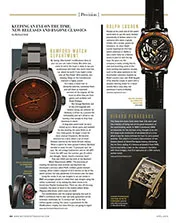
Precision, April 2015
Keeping an eye on the time: new releases and bygone classics by Richard Holt Bamford Watch Department By having ‘aftermarket’ modifications done to your car you can make it faster.…
Sir,
During the war various enthusiasts’ clubs have been formed all over the country, and having approximately the same aims. As an exam! le of their success, the 11 id land Motoring En thusiasts’ Club has gathered over 80 fully-paid Members in the 12 months of its existence.
It has been proved that there is a very real need for clubs of this nature. While offering entertainment, they have kept alive the true motoring spirit and assisted the pioneers Whose endeavour has been to bring about a motoring renaissance.
Throughout the war the teclutical Press has been fully alive to these facts arid has allotted a most. generous amount of space to criticisms and grievanees against pre-war conditions. isv extensive publication these views have largely reached unanimity ; but by contrast, the constructive thought in regard to future planning has been confined to the various groups throughout the country, so that we are in the position of having unity of purpose but no consolidated plan of action.
As a result of the improvement in the military siinai ion. and the prospect of it settlement in the at it too distant future, the time has conic for the adoption of a post-war policy. It is generally agreed that if any heed is to be paid to the desires of’ the motorists themselves. they must make their desires known, and these must be united as far as possible.
To bring this about, the M.M.E.C. proposes that a joint committee he set up to examine the situation and to make recommendations to the members of the constituent Clubs. As a preliminary step, this club has offered to arrange a meeting in Birmingham of’ nominated representatives on April 1st and 2nd. A numher of clubs have been notified, but if others are desirous of giving their co-operation, early application is requested to the hon. Secretary, Tile Glebe, South Road, Birmingham, 31.
It is to be regretted that some clubs which have gone into war-time hibernation may not be in a position to contribute, but they may rest assured that their -spheres would he adequately safeguarded. It must be understood, however, that to delay unification of policy until after the war would be a grave error, because, having regard to the speed at which events are 1110V il)!4 to-day, the t;overriment realise that. post-war policies must he settled now. So far as motorists are concerned, the matter is one of extreme urgency.
The 31.31.E.C. commends its proposal to the present and earnest, consideration of all motoring clubs and groups. If something on the lines suggested can be put into operation, this club is prepared to give it all the support in its power. At this time the promotion of motoring interests is more nearly within our grasp than ever before, and the opportunity may not arise again. Let it not be said of as who are left that we betrayed our trust. I am, Yours, etc.,
Birmingham, 14. GRAHAM C. Dix. Sir, “Two-Point-Six” is off on a new tack, reviving the momentarily quiescent. fable of 31r. Thursby-Pelham ‘s
M.G. I Jere he has the advantage over me, as he probably possesses more information about the excellent little T-type tInut I do. Setting aside the somewhat doubtful verification of Mr. Thurshy-Pelham’s claims, I will ask ” Two-Point-Six ” to join with Inc in considering the elementary Mathematics of the ease : he will
probably be able to help by giving me accurate data.
To begin with, I do not know the frontal area of a T-type, so until more exact information is forthcoming, let us assume that it is the eommendaLly low figure of 14 sq. ft.
Now, most, people helieve (as opposed to ” Two-Point-Six and Mr. ThursbyPelham) that the T-type is capable of an honest ’75 m.p.h., which is a very decent speed for a small, unsupercharged, unst reamlined motor-eat’. To propel an mist reandined motor-car
at 75 m.p.h. calls (I believe) for some 3 b.h.p. per square foot of frontal area. The T-type engine must therefore develop some ,ft: b.h.p. at 75 m.p.h. This is equal to 35 b.h.p. per litre, which is a good output for the type of engine, and roughly what one would expect. But to rush along at 31r. Thursby
Pelham’s 95 m.p.h. (modestly reduced by ” Two-Point-Six ” to only 92 Lill why this retivence ?) calls for exactly double this power, namely, 84 b.h.p., or 70 per litre. When one recolleets that neither the 2.9 Alfa-Romeo, nor the 51SC Bugatti—the most highly efficient supercharged production sports car in existence —attain this remarkable output, one is placed in a quandary in trying to reconcile the facts as put forward by Mr. ThursbyPelham and supported by ” wo-PointSix.”
Perhaps ” Two-Point-Six ” can bring his powers of reasoning to bear in demonstrating the fallacy of these figures. I am, Yours, etc.,
CECIL CL1.7170N.